Hey! I've been very inspired recently by two great books - How to photograph food by Bea Lubas and Brand Brilliance by Fiona Humberstone.
Both books talk a bit about colour theory in styling and photography, and although I must have covered this in my art A-level or foundation course, I realised I couldn't remember a single thing about it!
So I set myself a challenge to do some research and style a couple of shots with colour theory in mind. Turns out I have actually been using it as a tool in my styling all this time; I just didn't realise (or forgot) how and why.
First of all, let's explore the different ways you can select colours for styling and photography

Direct colour harmony, also known as a complementary colour harmony, uses two colours directly opposite on the colour wheel. (Teal and copper being a current fave!)
Using direct colour harmonies produces a high contrast, whereby warm & cool colours (from opposite sides of the colour wheel) are displayed side by side, in varying shades and tones.
This mimics the light and dark found in nature, but also the warm and cool tones of sunlight and shadow.
An example would be a vibrant, cold blue and a warm, bright yellow. Personally i don't find this very sophisticated but I do like to use green and pink together and I find this a lot softer even though it uses the same science.
In graphic or really playful photography direct or opposite colour choices can really work and if you're going to do it go bold i say!
However, if like me you prefer a more organic, subtle balance of colour I would use it in moderation - perhaps in smaller details to surprise and contrast here and there.
Triadic colour harmony includes three or more colours, spaced evenly around the colour wheel, producing the points of a triangle.
Triadic colour harmonies are often vibrant due to the spacing of the colours, with one dominant colour and other supporting colours. I notice it more in spring and summer food styling where pastel tones are used in a triadic (or quadratic) harmony.
Analogous colours sit next to each other on the colour wheel. Different tints, shades, and tones of the same colour work together to create a more subtle palette that uses light, shade and saturation to direct the focus. (As opposed to the high contrast in the direct colours above.)
This is my preferred way of selecting colours - either sticking with one key colour in various tones and strengths or a group of colours from one side of the colour wheel.
Its a very stylish (and popular) way to make your hero shine and keep the focus on the ingredients and flavours.
The best examples I've seen avoid introducing another colour in the backdrop by using clean, only black-based greys.
Two ways to use colour theory in your food styling and photography

For my first play I wanted to use only green in this guacamole shot. I knew it wouldn't be boring because there are so many beautiful green ingredients in it.
We've got the warm, yellowy lime and vibrant pea green peppers, olivey avocados and the strong coriander green going darker and cooler in the shadows.
I selected props that are light, textural and neutral to create the flow of the composition, going a little bolder with the clay plate to meet the strength of the coriander seeds and za'atar on top of the guac. (Side note; ground spices and herb pots are a fantastic way to bring in complimentary colours as well as a final flurry of texture, I have loads to hand in my studio!)
Looking back to the colour wheel - green and sandy beige would have made a nice triadic balance with some red (purple) onion which I did have in when i was 'going with my usual flow' (see the second image) but as I was trying to be more monochrome I took it out.
Which do you prefer? I think that little peep of red onion helps make a hero of the cracker instead of the bowl. Once you see it it keeps bringing your eye back to it, magic!
The backdrop is London which is an ever so slightly green-toned grey but i think this would look great on a black like Kyoto or maybe an almost blue dark grey like Powder. Personally I love bright colours on darker backdrops but in the name of research and to flex my styling muscles I went light for this one!
I chose to keep the shadows strong to the left instead of reflecting light back in as I like to keep a dynamic change of light across the set to give a bit of mood even in brighter shots. Maybe I will play around with using different lighting styles for another research project!


As I said, I love bold colours on dark backdrops so for my second shot (which is purely about playing with colour, not very edible at all!) I've used a really subtle black backdrop, Ash and kept the props dark too.
I used analogous colours that sit next to each other on the colour wheel; purples, pinks and a bit of orange. I love the effect this creates! Really dramatic and bold.
Because this shot already felt quite editorial, a little trick I like to use is 'directional scatters'. So the seeds and orange zest on the cabbage give another, quite edgy compositional element, rather than just adding another layer of texture and colour (which is useful too of course).
And even though I didn't want another strong element to the right of the beetroot dip, the oil drizzles catch the light beautifully against the dark backdrop.

What do you think? Have you tried these different ways of balancing colour or do you notice it in your work already anyway?
Generally speaking, everything that 'works' styling wise usually comes from nature so it makes sense that we do these things naturally sometimes too!
Here's the set up for the last shot and if you're interested there'll be a little IGTV vid on our Instagram of the progression of the styling soon too. (You'll see me swap out the onions for a different style of cut as I wasn't getting enough colour off them!)
Thank you for reading, I hope you've found it interesting? Please do comment below if you've enjoyed seeing this, I love to chat all things styling!
Take care,
Sophie xx
PS! This is my fave guacamole recipe - just smash this all together - 2 avocados, half a chilli, juice of 1 lime, handful chopped coriander, teaspoon each ground coriander and ground cumin, half a red onion really finely chopped. Drizzle with top quality olive oil, sprinkle over za'atar and toasted cumin and coriander seeds.







